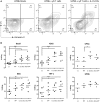Interleukin-15-Cultured Dendritic Cells Enhance Anti-Tumor Gamma Delta T Cell Functions through IL-15 Secretion
- PMID: 29692776
- PMCID: PMC5902500
- DOI: 10.3389/fimmu.2018.00658
Interleukin-15-Cultured Dendritic Cells Enhance Anti-Tumor Gamma Delta T Cell Functions through IL-15 Secretion
Abstract
Dendritic cell (DC) vaccination can be an effective post-remission therapy for acute myeloid leukemia (AML). Yet, current DC vaccines do not encompass the ideal stimulatory triggers for innate gamma delta (γδ) T cell anti-tumor activity. Promoting type 1 cytotoxic γδ T cells in patients with AML is, however, most interesting, considering these unconventional T cells are primed for rapid function and exert meaningful control over AML. In this work, we demonstrate that interleukin (IL)-15 DCs have the capacity to enhance the anti-tumoral functions of γδ T cells. IL-15 DCs of healthy donors and of AML patients in remission induce the upregulation of cytotoxicity-associated and co-stimulatory molecules on the γδ T cell surface, but not of co-inhibitory molecules, incite γδ T cell proliferation and stimulate their interferon-γ production in the presence of blood cancer cells and phosphoantigens. Moreover, the innate cytotoxic capacity of γδ T cells is significantly enhanced upon interaction with IL-15 DCs, both towards leukemic cell lines and allogeneic primary AML blasts. Finally, we address soluble IL-15 secreted by IL-15 DCs as the main mechanism behind the IL-15 DC-mediated γδ T cell activation. These results indicate that the application of IL-15-secreting DC subsets could render DC-based anti-cancer vaccines more effective through, among others, the involvement of γδ T cells in the anti-leukemic immune response.
Keywords: acute myeloid leukemia; dendritic cell vaccination; immunotherapy; interleukin-15; γδ T cells.
Figures





Similar articles
-
Transpresentation of interleukin-15 by IL-15/IL-15Rα mRNA-engineered human dendritic cells boosts antitumoral natural killer cell activity.Oncotarget. 2015 Dec 29;6(42):44123-33. doi: 10.18632/oncotarget.6536. Oncotarget. 2015. PMID: 26675759 Free PMC article.
-
Interleukin-12 production by leukemia-derived dendritic cells counteracts the inhibitory effect of leukemic microenvironment on T cells.Exp Hematol. 2005 Dec;33(12):1521-30. doi: 10.1016/j.exphem.2005.08.005. Exp Hematol. 2005. PMID: 16338495
-
Immune suppression by gammadelta T-cells as a potential regulatory mechanism after cancer vaccination with IL-12 secreting dendritic cells.J Immunother. 2010 Jan;33(1):40-52. doi: 10.1097/CJI.0b013e3181b51447. J Immunother. 2010. PMID: 19952957
-
The subtle interplay between gamma delta T lymphocytes and dendritic cells: is there a role for a therapeutic cancer vaccine in the era of combinatorial strategies?Cancer Immunol Immunother. 2021 Jul;70(7):1797-1809. doi: 10.1007/s00262-020-02805-3. Epub 2021 Jan 1. Cancer Immunol Immunother. 2021. PMID: 33386466 Free PMC article. Review.
-
The Dual Roles of Human γδ T Cells: Anti-Tumor or Tumor-Promoting.Front Immunol. 2021 Feb 16;11:619954. doi: 10.3389/fimmu.2020.619954. eCollection 2020. Front Immunol. 2021. PMID: 33664732 Free PMC article. Review.
Cited by
-
Research progress on dendritic cell vaccines in cancer immunotherapy.Exp Hematol Oncol. 2022 Jan 24;11(1):3. doi: 10.1186/s40164-022-00257-2. Exp Hematol Oncol. 2022. PMID: 35074008 Free PMC article. Review.
-
Exhausted intratumoral Vδ2- γδ T cells in human kidney cancer retain effector function.Nat Immunol. 2023 Apr;24(4):612-624. doi: 10.1038/s41590-023-01448-7. Epub 2023 Mar 16. Nat Immunol. 2023. PMID: 36928415 Free PMC article.
-
PD-1 signaling modulates interferon-γ production by Gamma Delta (γδ) T-Cells in response to leukemia.Oncoimmunology. 2018 Dec 14;8(3):1550618. doi: 10.1080/2162402X.2018.1550618. eCollection 2019. Oncoimmunology. 2018. PMID: 30723581 Free PMC article.
-
Ex vivo pulsed dendritic cell vaccination against cancer.Acta Pharmacol Sin. 2020 Jul;41(7):959-969. doi: 10.1038/s41401-020-0415-5. Epub 2020 May 4. Acta Pharmacol Sin. 2020. PMID: 32366940 Free PMC article. Review.
-
Functional Phenotypes of Human Vγ9Vδ2 T Cells in Lymphoid Stress Surveillance.Cells. 2020 Mar 22;9(3):772. doi: 10.3390/cells9030772. Cells. 2020. PMID: 32235722 Free PMC article. Review.
References
Publication types
MeSH terms
Substances
LinkOut - more resources
Full Text Sources
Other Literature Sources
Medical

